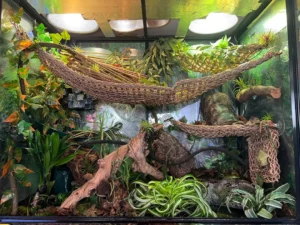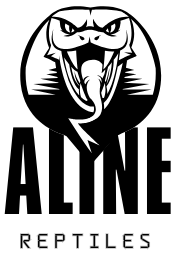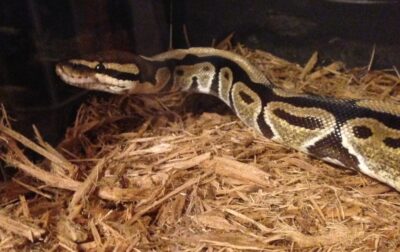Imagine bringing home a beautiful ball python, only to realize that its enclosure isn’t set up correctly—leading to stress, poor health, or even escape. A well-designed ball python enclosure is crucial for keeping your pet comfortable, secure, and healthy.
In this comprehensive guide, we’ll walk you through everything you need to know about setting up the perfect habitat for your ball python. From choosing the right enclosure type to maintaining the proper humidity and temperature, we’ve got you covered. Let’s dive in.
Choosing the Right Enclosure Size

One of the first decisions you’ll make is selecting the right-sized enclosure for your ball python. Size matters, as too much space can make young snakes feel insecure, while too little space can hinder movement and activity.
| Age/Size of Ball Python | Recommended Enclosure Size |
|---|---|
| Hatchling (<1 year) | 20-gallon tank (24”x12”x12”) |
| Juvenile (1-3 years) | 40-gallon tank (36”x18”x18”) |
| Adult (>3 years) | 4x2x2 feet or larger |
A well-sized enclosure provides enough space for exploration without overwhelming your snake.
Types of Enclosures
There are several types of enclosures available, each with pros and cons:
1. Glass Tanks
- Pros: Readily available, easy to clean, great for viewing
- Cons: Harder to maintain humidity, may need modifications
2. Plastic/PVC Enclosures
- Pros: Excellent heat and humidity retention, lightweight
- Cons: More expensive, less visibility
3. Custom-Built Vivariums
- Pros: Tailored to needs, great for bioactive setups
- Cons: Time-consuming to build, potentially costly
Heating and Temperature Regulation
ball python enclosure are cold-blooded reptiles, meaning they rely on their environment to regulate body temperature. Your enclosure should include:
| Temperature Zone | Ideal Temperature Range |
| Basking Spot | 88-92°F (31-33°C) |
| Warm Side | 80-85°F (27-29°C) |
| Cool Side | 75-78°F (24-26°C) |
Heating Options:
- Under-tank heat mats (requires thermostat)
- Ceramic heat emitters (no light emission)
- Radiant heat panels (good for larger enclosures)
Always use a thermostat to regulate heating and prevent burns or overheating.
Lighting Requirements

Unlike some reptiles, ball pythons do not require UVB lighting, but providing a natural day/night cycle helps maintain their biological rhythms.
- Natural lighting (place enclosure in a room with natural daylight)
- Low-wattage LED bulbs for visibility (optional)
- 12-hour light cycle to mimic nature
Humidity Control
Proper humidity levels are crucial for shedding and respiratory health.
| Humidity Level | Purpose |
| 50-60% | Daily Maintenance |
| 65-75% | During Shedding |
Ways to Maintain Humidity:
- Use a cypress mulch or coconut husk substrate
- Mist the enclosure lightly if necessary
- Provide a large water bowl
- Cover part of the enclosure lid to trap moisture
Substrate Options
Choosing the right substrate (bedding) can impact your snake’s comfort and humidity retention.
| Substrate Type | Pros | Cons |
| Aspen Shavings | Easy to clean, affordable | Poor humidity retention |
| Cypress Mulch | Retains humidity well | Needs occasional replacement |
| Coconut Husk | Excellent for humidity | Can be expensive |
| Paper Towels | Hygienic, great for quarantines | Looks unnatural |
Enclosure Furnishings
Your ball python needs more than just an empty tank. Essential enclosure furnishings include:
1. Hides
- At least two hides (one on the warm side, one on the cool side)
- Should be snug for security
2. Water Bowl
- Large enough for soaking
- Clean regularly to prevent bacteria buildup
3. Climbing Structures & Decorations
- Branches, logs, and artificial plants add enrichment
- Avoid sharp objects that could cause injury
Bioactive Enclosure Setup
For advanced keepers, a bioactive enclosure can create a naturalistic environment.
Key Components:
- Live plants (snake-safe)
- Cleanup crew (isopods, springtails)
- Layers: drainage, soil, leaf litter
Bioactive setups reduce cleaning needs and promote a self-sustaining ecosystem.
Cleaning and Maintenance

A well-maintained enclosure prevents disease and keeps your snake healthy.
Routine Cleaning:
| Frequency | Task |
| Daily | Remove waste, change water |
| Weekly | Spot clean substrate, wipe down glass |
| Monthly | Deep clean enclosure, replace substrate |
Common Mistakes to Avoid
- Improper Temperature Gradient – Too hot or too cold can lead to stress.
- Using Cedar or Pine Substrate – These are toxic to snakes.
- Overfeeding or Underfeeding – Can lead to obesity or malnutrition.
Conclusion
Setting up the perfect ball python enclosure ensures your pet thrives in a safe, comfortable environment. From selecting the right size and type of enclosure to maintaining proper heating, humidity, and furnishings, every detail matters. With proper care and attention, your ball python will enjoy a healthy and stress-free life. Now, it’s time to create the ultimate home for your snake—happy herping.

